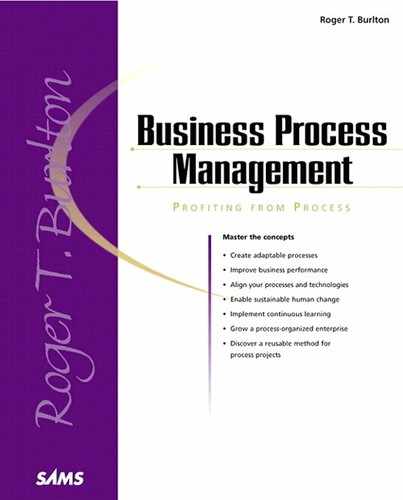Chapter 6. Project Management Essentials
|
In This Chapter |
The next three chapters cover a set of interrelated and complementary issues. Project management, risk management, and human change management must all be included in the consideration of change. If they are not addressed, they could become the cause of failure regardless of the excellence of the process management methodology you choose.
Clearly the project manager must ensure that activities for risk assessment are included in project plans. Likewise, human change can make up the lion’s share of work in many initiatives, and itself become the biggest risk. Plans and control activities must allow time to deal with these changes. It’s also likely that the project manager will be the one to assure that project management, risk management, and human change management happen, while conducting and keeping in sync all the activities in the process management framework.
Over the years, project management has proven to be the umbrella principle governing most professional practices and is clearly needed in all of them. Unfortunately, it seems to be recognized as valuable only when there’s a huge cost of non-conformance.
NASA experienced this when the agency admitted that “Poor training and communication inside the Mars team and its failure to follow procedures allowed a tiny metric conversion mistake to destroy the $125 million Mars Climate Orbiter.” Numerous IT infrastructure and application development projects have suffered from poor project management when the deadline became more important than the results, and so-called solutions were implemented only to be abandoned later.
Business process approaches are no different if they aren’t managed. They fail more because of project management breakdown than because of professional methodological or technical reasons. If the wrong project structure is in place, if planning activities are short circuited, if control mechanisms aren’t executed, if unskilled or uncaring people are assigned the wrong tasks, if resources aren’t committed, and no time is spent on oversight—to name just a few aspects—it should be no surprise when a project fails, as it inevitably will. When it does, we must not blame the professional practices, only the organization’s commitment to them.
Professional practices are unique to the type of work being performed. Writing a procedural guide is different from writing a Java program. However, all professional practices have the following attributes:
They provide a set of guidelines for execution of defined phases and activities.
They are conducted in a disciplined order.
Their results are deliverables whose format and level of detail are defined. These results can be compared to objective standards.
They define target results that will guide those responsible for the project management execution.
They provide a common framework for communication among project players.
Conversely, some say that project management is an art that can’t be structured. Although there is some art in it, you can’t hope that a manager is a good one by nature only. Project management can be a disciplined approach and still have room for interpretation and judgment. Because every project is different, it’s implicit that the project management process must be adaptable. Projects are
Unique— Driven by a set of specific, one-time objectives and deliverables.
Temporary— They have a definite start and finish.
Uncertain and therefore risky— The product or service created varies in some distinguishing way from all other products/services, even for those initiatives that are similar.
Multifunctional— They cross organizational boundaries in scope, impact, and resource consumption.
Dependent— They need varying amounts of resources—such as time, money, equipment, and human resources—from organizations other than their own.
Of variable size— In scope, time, participants, and business functions involved.
Consequently, the overarching project management practice can be seen as having a set of attributes different from professional practice management. Project management is the art and science of achieving project completion by doing the right things in the right way. More specifically
It provides the process that identifies, plans, controls, and completes a change project.
It describes the means of producing project results and gaining customer acceptance for them.
It applies to all projects, stages, and deliverables regardless of type, size, and duration, and to all people involved in them.
This final attribute, universal application of project management, occurs in many ways:
Through the delegation, monitoring, and sharing of responsibilities for results with a team
Through the maintenance of personal commitments toward results and deliverables
By providing commonly understood/accepted plans
By establishing effective communication channels for project control and continuous improvement operating cyclically (based on a calendar)
By establishing unambiguous hand-over/acceptance mechanisms
Regardless of the scope and size of the project or deliverable, four major stages are involved:
Initiating (defining the work)
Planning (planning the work)
Accepting (accepting the work)
Although project management is a wide topic, the rest of this chapter will focus on key aspects that are particularly critical for process management initiatives. I will cover some important fundamentals as well as the four major stages of making project management work. I will also cover a set of roles and structures particularly suited to this type of change.
